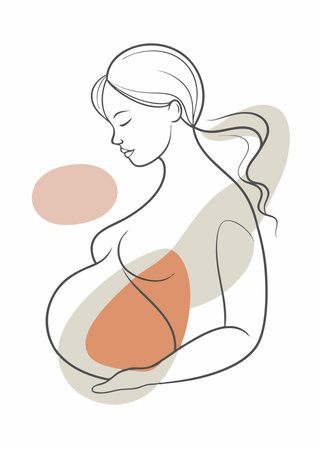1. Latching Difficulties
Many new moms in the U.S. find themselves facing latching difficulties when they start breastfeeding. A proper latch is key for both comfort and making sure your baby gets enough milk. If a baby isn’t latched on well, it can lead to sore nipples, fussiness during feedings, and even slow weight gain for your newborn.
Common Signs of Latching Problems
| Sign | What You Might Notice |
|---|---|
| Painful Nursing | Your nipples hurt or feel cracked after feeding. |
| Clicking Sounds | You hear clicking or smacking noises as your baby nurses. |
| Poor Milk Transfer | Your baby seems hungry right after eating or has fewer wet diapers than expected. |
| Shallow Latch | Your baby’s mouth covers only the nipple, not the areola. |
How to Achieve a Good Latch
- Positioning: Hold your baby close with their tummy facing yours. Their nose should be level with your nipple before they latch on.
- Lip Flange: Make sure your baby’s lips are flared outward, like a fish, and their chin touches your breast.
- Mouth Wide Open: Wait for your baby to open wide before guiding them onto the breast so more of the areola goes into their mouth.
- Comfort Check: You should feel a tugging sensation but not pain while nursing.
When to Get Support
If you keep having trouble with latching or if nursing is painful, don’t hesitate to reach out for help. Many hospitals and pediatrician offices in the U.S. have lactation consultants who can give hands-on guidance and support. There are also community groups like La Leche League and WIC (Women, Infants, and Children) that offer free breastfeeding support and advice.
2. Sore Nipples and Breast Pain
Sore nipples and breast pain are common for many moms, especially in the first few days or weeks of breastfeeding. While it can feel discouraging, these issues often improve with a few simple adjustments and some self-care.
Why Do Sore Nipples and Breast Pain Happen?
Most nipple pain comes from problems with how your baby latches onto the breast. Other causes include frequent nursing, sensitive skin, or not switching positions often enough. Sometimes, breast pain may also be due to engorgement (when breasts get very full) or blocked milk ducts.
Tips to Relieve Sore Nipples and Breast Pain
| Challenge | How to Overcome It |
|---|---|
| Poor latch | Make sure your babys mouth is wide open before latching. Most of your areola (the darker area around the nipple) should be in your baby’s mouth, not just the nipple itself. |
| Painful nursing position | Try different breastfeeding positions (cradle hold, football hold, side-lying). Use pillows for support and comfort. |
| Sore or cracked nipples | Apply a lanolin-based nipple cream after feedings. Let nipples air dry. Avoid harsh soaps or wipes on your nipples. |
| Engorgement or blocked ducts | Nurse frequently, use warm compresses before feeding, and gently massage any sore spots while your baby nurses. |
When to Seek Help
If you notice severe pain that doesn’t improve, bleeding, or signs of infection like redness or fever, reach out to a lactation consultant or your healthcare provider. Getting support early can make breastfeeding much more comfortable and enjoyable for both you and your baby.

3. Low Milk Supply Concerns
Worrying about not producing enough milk is one of the most common fears among new moms in the United States. Many mothers wonder if their baby is getting enough to eat, especially during growth spurts or when babies seem extra fussy. The good news is that low milk supply is often more of a concern than an actual issue, and there are several ways to support healthy milk production.
Signs Your Baby Is Getting Enough Milk
| Sign | What to Look For |
|---|---|
| Wet Diapers | At least 6 wet diapers per day after the first week |
| Weight Gain | Steady weight gain after the initial loss in the first few days |
| Content After Feedings | Your baby seems satisfied and relaxed after nursing |
| Frequent Feedings | Nursing every 2-3 hours (8-12 times in 24 hours) |
Tips to Boost Milk Supply
- Nurse Often: Breastfeeding works on a supply-and-demand basis. The more you nurse, the more milk your body will make.
- Stay Hydrated: Drink plenty of water throughout the day. Keep a water bottle handy while nursing.
- Eat Balanced Meals: Nutritious foods help support your energy and milk production.
- Skin-to-Skin Contact: Holding your baby skin-to-skin can encourage more frequent feedings and help with milk production.
- Avoid Skipping Feedings: Try to nurse or pump regularly, even at night, to keep up your supply.
- Consider Pumping: If you need to be away from your baby, pumping can help maintain your milk supply.
- Relax as Much as Possible: Stress can sometimes impact milk supply, so try to rest and relax when you can.
- Reach Out for Support: Consult a lactation consultant or healthcare provider if you have concerns about your milk supply. They can offer personalized advice and check for any underlying issues.
When to Talk to a Healthcare Provider
If you notice that your baby isn’t gaining weight, has fewer than six wet diapers a day after the first week, or still seems hungry after most feedings, it’s a good idea to reach out for professional support. Lactation consultants and pediatricians are great resources for breastfeeding families in the U.S. Remember, every mom and baby pair is unique—getting help early can make breastfeeding easier for both of you.
4. Engorgement and Clogged Ducts
Breast engorgement and clogged (plugged) milk ducts are common challenges for many new moms in the U.S. They can make breastfeeding feel uncomfortable and even lead to more serious issues like mastitis if not managed early.
What Are Engorgement and Clogged Ducts?
Engorgement happens when your breasts become overly full of milk, making them swollen, hard, and sometimes painful. A clogged duct occurs when milk flow gets blocked in one part of the breast, leading to a tender lump or sore spot.
Common Signs
| Engorgement | Clogged Ducts |
|---|---|
| Swollen, tight breasts Shiny skin Mild fever possible Discomfort during nursing |
Tender lump in breast Soreness or pain Redness over the area Milk supply may drop on that side |
How to Relieve Engorgement and Clogged Ducts
- Nurse Frequently: Feed your baby often, at least every 2-3 hours, to keep milk moving.
- Warm Compresses: Apply a warm washcloth or take a warm shower before feeding to help milk flow.
- Gentle Massage: Gently massage the breast toward the nipple while nursing or pumping.
- Change Nursing Positions: Try different breastfeeding positions to help drain all areas of the breast.
- If Needed, Hand Express or Pump: If your baby cant empty the breast, hand express or pump just enough to relieve discomfort.
- Avoid Tight Bras: Wear comfortable bras that don’t put pressure on your breasts.
When to Seek Help
If you develop a fever over 101°F, notice red streaks on your breast, or feel flu-like symptoms, contact your healthcare provider. These could be signs of mastitis, an infection that needs prompt treatment.
5. Navigating Breastfeeding in Public and Returning to Work
Many moms feel anxious about breastfeeding in public or managing breastfeeding after returning to work. These are common challenges, but with a little preparation and understanding of your rights, you can make the process much smoother. Here’s what you need to know:
Understanding Your Rights
In the United States, federal law protects your right to breastfeed in public and pump at work. Knowing these laws can help you feel more confident.
| Situation | Your Rights |
|---|---|
| Breastfeeding in Public | Legal in all 50 states; you cannot be asked to leave or cover up |
| Pumping at Work | The Fair Labor Standards Act (FLSA) requires employers to provide reasonable break time and a private space (not a bathroom) for pumping for up to one year after your child’s birth |
Tips for Breastfeeding in Public
- Practice at Home: Before heading out, practice latching and nursing with a nursing cover or scarf so you feel comfortable.
- Choose Comfortable Outfits: Wear tops designed for easy nursing access—button-down shirts or special nursing tops can make breastfeeding discreet and simple.
- Nursing Covers: If it helps you feel more confident, use a lightweight nursing cover or large scarf. Some moms prefer using a baby carrier for extra privacy.
- Scout Locations: Many malls, airports, and public buildings have dedicated nursing rooms. Apps like “Mommy Nearest” can help you find breastfeeding-friendly spots nearby.
Pumping and Returning to Work
Returning to work is a big transition, but planning ahead makes it manageable. Here are some tips:
- Talk to Your Employer Early: Discuss your needs before returning so they can help arrange a private space and flexible break times for pumping.
- Create a Pumping Schedule: Try to pump around the same times your baby would normally feed to keep up your milk supply.
- Have the Right Gear: Invest in a reliable breast pump, storage bags or bottles, and an insulated cooler bag for transporting milk safely.
- Label Everything: Clearly label milk containers with your name and date if storing milk at work.
- Stay Positive: There might be some trial and error as you adjust. Don’t hesitate to ask for support from HR or other working moms in your workplace.
Pumping Schedule Example for Working Moms
| Time of Day | Pumping Session |
|---|---|
| Before leaving home | Pump once after feeding baby if needed |
| Mid-morning (around 10 am) | Pump during first scheduled break at work |
| Lunchtime (around 1 pm) | Pump during lunch break |
| Afternoon (around 3-4 pm) | Pump during afternoon break before heading home |
| Evening (after returning home) | Nurse baby directly or pump if necessary |


